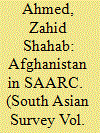|
|
|
Sort Order |
|
|
|
Items / Page
|
|
|
|
|
|
|
| Srl | Item |
| 1 |
ID:
159413


|
|
|
|
|
| Summary/Abstract |
Ever since the formation of the South Asian Association for Regional Cooperation
(SAARC) in 1985, the motivation for the expansion of the Association has been
expressed by its founding members. The prospective expansion comes naturally
to international organisations (IOs), visible in the increase in membership of
the European Union (EU) from six to 28 European countries. Similarly, the
Association of Southeast Asian Nations (ASEAN) has doubled its membership
since its inception. SAARC membership grew in 2007, with the inclusion of
Afghanistan. Yet, there is limited assessment on the opportunities and challenges
that have arisen since Afghanistan’s arrival in SAARC 10 years ago. This article
provides an evaluation of Afghanistan within SAARC, and a further comparison
to processes of enlargement in the EU and ASEAN. It is argued that Afghanistan’s
membership poses significant challenges for SAARC, owing to its political instability.
Its stature as a war-torn country has meant that it has failed to prioritise its role
in the Association. Furthermore, the membership of Afghanistan has significantly
contributed to the conflict relationship between Afghanistan and Pakistan, further
constraining SAARC processes and agendas.
|
|
|
|
|
|
|
|
|
|
|
|
|
|
|
|
| 2 |
ID:
159414


|
|
|
|
|
| Summary/Abstract |
The foreign policy of Ceylon under the premiership of D.S. Senanayake maintained
a distinct alignment with its former coloniser Great Britain. The zenith
of this relationship was the defence agreement which came into effect upon
independence in 1948. Utilising the existing scholarship on neorealism and the
concept of security dilemma, analysis of the reasons behind this strategic alignment
exposes the threat perception Ceylon faced from its regional hegemon,
India. This study surveys such threat perceptions faced by the island at the time
of independence and argues that this led to a balancing strategy with Britain. It
first locates Ceylon’s foreign policy employing the taxonomies of balancing, bandwagoning
and hedging and then examines how Ceylon’s extra-regional alignment
with the UK enabled her to eschew from a security dilemma with India.
|
|
|
|
|
|
|
|
|
|
|
|
|
|
|
|
| 3 |
ID:
159410


|
|
|
|
|
| Summary/Abstract |
The present article makes an attempt to empirically examine the linkage between
board composition and financial performance of the listed Indian and Chinse
firms spanning over the period from 2010 to 2014. Board composition comprises
of the four variables, namely, board size, auditors’ quality, CEO duality
and proportion of independent directors on the board. The study finds that for
Indian firms, the separation between the chief executive officer (CEO) and the
chairperson does have positive impact on the firms’ return on equity (ROE),
while for the Chinese firms, the proportion of independent directors on the
board does significantly influence ROE of the firms. Firms with higher proportion
of independent directors on their boards experience greater ROE. However,
auditors’ quality and board size are not found to have any impact on the ROE of
the firms of either country.
|
|
|
|
|
|
|
|
|
|
|
|
|
|
|
|
| 4 |
ID:
159412


|
|
|
|
|
| Summary/Abstract |
In the last decade, local governance has emerged as one of the most significant
issues in development discussion. NGOs and international agencies have placed
themselves in a strategic position to focus on this subject in the recent times.
They are now more involved in capacitating local government institutions (LGIs)
and the local community to understand roles and responsibilities and act effectively
towards responsive and participatory governance. NGOs have a special
place in the socio-economic development in Bangladesh, and many of the popular
NGO models have been replicated in different parts of the world. In the last four
decades, the operation of NGOs has seen growth and also criticisms regarding
how many of these NGOs have transformed themselves from non-profit-oriented
organisations to money-driven unit in Bangladesh. However, NGOs, with a
change in approach—from relief and rehabilitation to community development
and now right-based development—have still found themselves in an important
position in Bangladesh. In the recent years, some of the prominent NGOs and
international development partners have made an enormous contribution in
strengthening LGIs by facilitating the process of ensuring people’s participation,
and transparency and accountability of the overall governing process.
|
|
|
|
|
|
|
|
|
|
|
|
|
|
|
|
| 5 |
ID:
159411


|
|
|
|
|
| Summary/Abstract |
Terrorism, using the social media, has become one of the most concerning
issues across the world. There is interplay between home-grown terrorist
groups and international terrorist organisations which is playing the central
role in accelerating the situations. Terrorist organisations are using social
media platforms for recruiting, training and communicating with their followers,
supporters, donors, as it is cheaper, easier, faster and effective method of
communication. The members of the terrorist organisations are spreading
their ideological thoughts, propaganda and their activities, not only to South
Asia but also to the world, using social media platforms. Through qualitative
analysing, this article will find out how terrorist groups are using social media
platforms, especially in South Asia, threatening the peace and security of the
countries. While discussing the present conditions of the South Asian countries,
this article emphasises on Bangladesh, India and Pakistan. This article will also
explain some policy recommendations that can be very useful for the fight
against terrorism in the social media platforms.
|
|
|
|
|
|
|
|
|
|
|
|
|
|
|
|
|
|
|
|
|